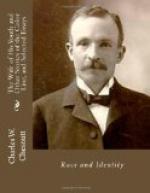Cicely lifted the sick man’s head, and Dinah poured a few drops of the whiskey between his teeth. He swallowed it readily enough. In a few minutes he opened his eyes and stared blankly at the two women. Cicely saw that his eyes were large and black, and glistening with fever.
“How you feelin’, suh?” asked the old woman.
There was no answer.
“Is you feelin’ bettah now?”
The wounded man kept on staring blankly. Suddenly he essayed to put his hand to his head, gave a deep groan, and fell back again unconscious.
“He ’s gone ag’in,” said Dinah. “I reckon we ’ll hafter tote ’im up ter de house and take keer er ’im dere. W’ite folks would n’t want ter fool wid a nigger man, an’ we doan know who his folks is. He ’s outer his head an’ will be fer some time yet, an’ we can’t tell nuthin’ ’bout ’im tel he comes ter his senses.”
Cicely lifted the wounded man by the arms and shoulders. She was strong, with the strength of youth and a sturdy race. The man was pitifully emaciated; how much, the two women had not suspected until they raised him. They had no difficulty whatever, except for the awkwardness of such a burden, in lifting him over the fence and carrying him through the cornfield to the cabin.
They laid him on Cicely’s bed in the little lean-to shed that formed a room separate from the main apartment of the cabin. The old woman sent Cicely to cook the dinner, while she gave her own attention exclusively to the still unconscious man. She brought water and washed him as though he were a child.
“Po’ boy,” she said, “he doan feel lack he ‘s be’n eatin’ nuff to feed a sparrer. He ‘pears ter be mos’ starved ter def.”
She washed his wound more carefully, made some lint,—the art was well known in the sixties,—and dressed his wound with a fair degree of skill.
“Somebody must ‘a’ be’n tryin’ ter put yo’ light out, chile,” she muttered to herself as she adjusted the bandage around his head. “A little higher er a little lower, an’ you would n’ ‘a’ be’n yere ter tell de tale. Dem clo’s,” she argued, lifting the tattered garments she had removed from her patient, “don’ b’long ‘roun’ yere. Dat kinder weavin’ come f’om down to’ds Souf Ca’lina. I wish Needham ’u’d come erlong. He kin tell who dis man is, an’ all erbout ’im.”
She made a bowl of gruel, and fed it, drop by drop, to the sick man. This roused him somewhat from his stupor, but when Dinah thought he had enough of the gruel, and stopped feeding him, he closed his eyes again and relapsed into a heavy sleep that was so closely akin to unconsciousness as to be scarcely distinguishable from it.
When old Needham came home at noon, his wife, who had been anxiously awaiting his return, told him in a few words the story of Cicely’s discovery and of the subsequent events.
Needham inspected the stranger with a professional eye. He had been something of a plantation doctor in his day, and was known far and wide for his knowledge of simple remedies. The negroes all around, as well as many of the poorer white people, came to him for the treatment of common ailments.




